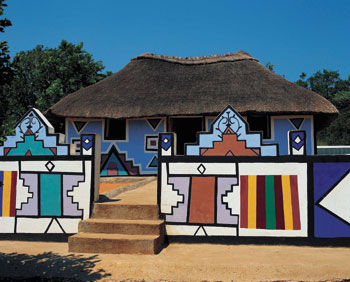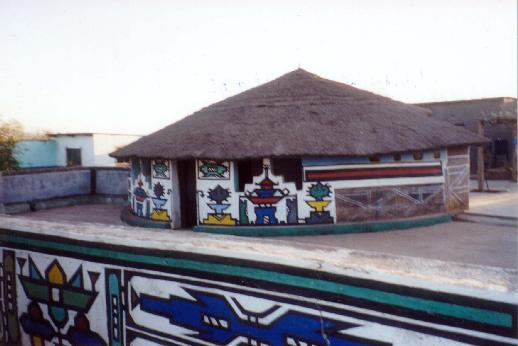NDEBELE
The remarkable spatial, formal and decorative qualities of
southern Ndebele art and architecture strongly
 affirm
the identity of a displaced people. Examination of their rituals and artefacts
offers fascinating insights into
how a culture under threat engages its creative power in an act of renewal. In
the climate of change being heralded
by the new South Africa, the search continues for an appropriate architectural
identity rooted in the African soft. In the latter part of the twentieth
century, a rural group of indigenous people in South Africa spoke and gave
expression to a unique and appropriate architecture as part of their quest for
cultural identity. They are the southern Ndebele.
affirm
the identity of a displaced people. Examination of their rituals and artefacts
offers fascinating insights into
how a culture under threat engages its creative power in an act of renewal. In
the climate of change being heralded
by the new South Africa, the search continues for an appropriate architectural
identity rooted in the African soft. In the latter part of the twentieth
century, a rural group of indigenous people in South Africa spoke and gave
expression to a unique and appropriate architecture as part of their quest for
cultural identity. They are the southern Ndebele.
Ndebele architecture has been viewed as a style, but the
inherent nature and structure of it is a demonstration of how rural women give
aesthetic and architectonic order to their world. The architecture of the
southern Ndebele
is rooted in its history and context. Climate and social organisation are the
basic determinants of form. Ndebele art and architecture show uniquely how a
minority group existing in a multi-cultural milieu (exposed to both traditional
tribal and twentieth-century Western influence) can through adaptation and
appropriation develop a unique hybrid artistic and architectural expression as
part of a quest to claim their cultural identity.
In the sixteenth century, the southern Ndebele were a splinter
group which broke away from the southward migration of the Nguni people who went
on to establish the Zulu empire. The southern Ndebele moved into the mile-high
savannah grassland plateaus of the Transvaal where they co-existed with the
neighbouring Sotho-Tswana from whom they were to adopt and adapt a climatically
efficient courtyard architec ture.
The two main South African ethnic groups - Nguni and Sotho/Tswana - lived in
settlements which were representative of a cattle culture. The focus of the
settlement was the cattle byre - a male dominated spatial centre, around which a
circular settlement pattern, representing the greater chieftaincy, was established.
The Ndebele were to adopt the courtyard architecture of these settlements. The
basic spatial model is that of a rectangular walled court, with the
centrally-sited main house divided into a front and back. The courtyard
functions as an outdoor room where much of the daily cooking, washing and
socialising takes place. The house itself provides sleeping, living and storage
accommodation.The homestead is an efficient model of climatic control - in its
low humidity environment, the courtyard ventilates well in summer, while
trapping heat in winter. The thickened out bases of the courtyard walls provide
seats affording comfort and protection from wind and sun. Ndebele homesteads
also function as part of the ritual process of the rites of passage. The
frequently-practised rituals provide the
pretext for decoration and architectural embellishment. The homestead itself
becomes the decorated backdrop to the performance of these ceremonies which take
place both within and outside its courts. In affirming Ndebele identity, art and
architecture form a crucial part of the ritual process.
ture.
The two main South African ethnic groups - Nguni and Sotho/Tswana - lived in
settlements which were representative of a cattle culture. The focus of the
settlement was the cattle byre - a male dominated spatial centre, around which a
circular settlement pattern, representing the greater chieftaincy, was established.
The Ndebele were to adopt the courtyard architecture of these settlements. The
basic spatial model is that of a rectangular walled court, with the
centrally-sited main house divided into a front and back. The courtyard
functions as an outdoor room where much of the daily cooking, washing and
socialising takes place. The house itself provides sleeping, living and storage
accommodation.The homestead is an efficient model of climatic control - in its
low humidity environment, the courtyard ventilates well in summer, while
trapping heat in winter. The thickened out bases of the courtyard walls provide
seats affording comfort and protection from wind and sun. Ndebele homesteads
also function as part of the ritual process of the rites of passage. The
frequently-practised rituals provide the
pretext for decoration and architectural embellishment. The homestead itself
becomes the decorated backdrop to the performance of these ceremonies which take
place both within and outside its courts. In affirming Ndebele identity, art and
architecture form a crucial part of the ritual process.
The emergence of a distinct Ndebele identity has its origins as
a result of the Ndebele defeat at the hands of the Boers in 1883, the resultant
dislocation of the tribe, their subsequent indenture, protracted slavery and
restrictions on their movement. The Ndebele women took responsibility for
re-establishing their extended families which were now isolated, as units, on
farms. By doing this the former male-dominated spatial centre of the
cattle-culture was shifted to that of the home. In the early 1940s the Ndebele
found themselves servants to white landlord farmers. This labour tenancy
afforded them the opportunity to develop an artistic expression centred around
their homes, celebrating their identity through the rites of passage. With
remarkable tenacity, they protected their language while assimilating
successfully with various Other cultures.
Home to the Ndebele is not a house in the Western sense, it is
the greater extent of the landholding of which the courtyards, the detached huts
of the settlement, the cattle byre, chicken runs and cultivated fields are all
perceived as one. There is a clear articulation between the domain of the women
and the domain of the men, which face one another across the arrival area. The
courts offer a rich diversity of options, choices and spatial experiences of the
Ndebele outdoor rooms. The views afforded between pavilions and across courts can be
likened to the open-ended experience of a village, prompting an African
interpretation of Palladio's notion that 'a
house is not a home unless it is a village'.
outdoor rooms. The views afforded between pavilions and across courts can be
likened to the open-ended experience of a village, prompting an African
interpretation of Palladio's notion that 'a
house is not a home unless it is a village'.
The southern Ndebele's adherence to traditional cultural codes
of behaviour provided the discipline which determined the basic form and
organisation of the homestead. A homestead reflects a polygamous man and the
courtyards of his wives. There is an explicit social order within the imuzi (or
homestead) - the social interaction between the place of men and that of women
is evident in both the ceremonial and daily rituals. Each wife's territory is
clearly demarcated by its own courtyard, home and allied pavilions. The
left/right relationship of wives' homesteads located next to each other, gives
rise to the aesthetic and spatial notion of symmetry and duality.

http://findarticles.com/p/articles/mi_m3575/is_n1177_v197/ai_16788145
 affirm
the identity of a displaced people. Examination of their rituals and artefacts
offers fascinating insights into
how a culture under threat engages its creative power in an act of renewal. In
the climate of change being heralded
by the new South Africa, the search continues for an appropriate architectural
identity rooted in the African soft. In the latter part of the twentieth
century, a rural group of indigenous people in South Africa spoke and gave
expression to a unique and appropriate architecture as part of their quest for
cultural identity. They are the southern Ndebele.
affirm
the identity of a displaced people. Examination of their rituals and artefacts
offers fascinating insights into
how a culture under threat engages its creative power in an act of renewal. In
the climate of change being heralded
by the new South Africa, the search continues for an appropriate architectural
identity rooted in the African soft. In the latter part of the twentieth
century, a rural group of indigenous people in South Africa spoke and gave
expression to a unique and appropriate architecture as part of their quest for
cultural identity. They are the southern Ndebele.

